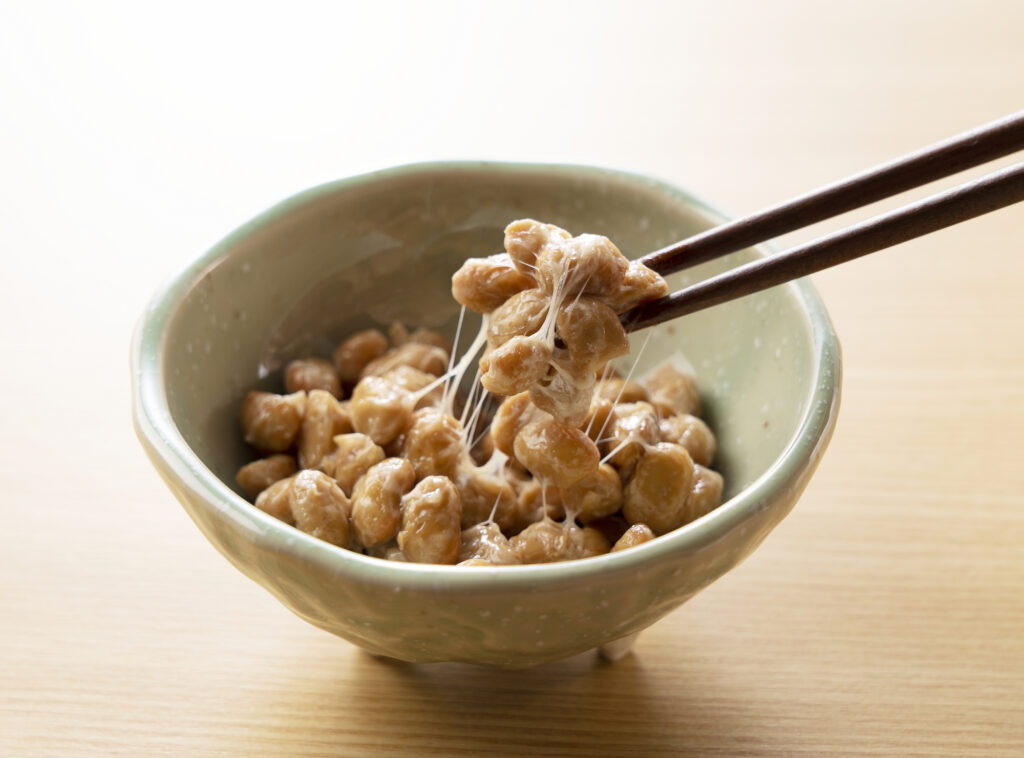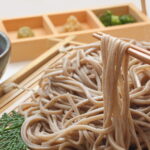Natto, a traditional Japanese dish made from fermented soybeans, is an everyday meal for many Japanese people. This popular breakfast food is the Japanese equivalent to the Western breakfast plate of eggs, bacon and toast, and it can be served in a variety of ways. You can even add natto to sauces or marinades to enjoy some unique flavors—not to mention all the health benefits this unique food delivers.
While it’s a staple food in Japan, many tourists and foreigners have never heard of natto and, at first glance, might be reluctant to try it. The sticky, slimy texture and pungent aroma of natto can be off-putting to those who aren’t sure what to expect from it. That said, once you get used to this fermented food, it becomes easier to stomach—and even downright enjoyable when paired with the right foods!
Whether you’re planning a visit to Japan or you’re curious about traditional Japanese cuisine, you need to try natto at least once in your life. Read on to get to know more about this special dish, including how to eat this healthy, uniquely-textured and -flavored food.

Soybeans are a staple in Japanese cuisine
When most people think of Japanese cuisine, they picture miso soup, ramen or sushi. No matter what food you’re thinking of, there’s a good chance it wouldn’t be the same dish if not for soybeans. Next to rice and wheat, the soybean is one of the most important crops in Japan. It not only plays a key role in cropping systems as a legume, it’s also one of the traditional sources of protein for Japanese people.
The Japanese have cultivated soybeans for thousands of years, but they became more popular in cooking around 1,300 years ago. At this time, tofu and hishio—the forerunner to miso and soy sauce—were introduced to the country by industrious monks. Today, so many favorite Japanese dishes feature the soybean prominently.
While virtually unknown in Western cultures, natto is yet another beloved Japanese dish made with this essential crop. Since around the 10th Century, the Japanese people have loved natto, and many even connect the dish to their flawless, age-defying skin!
How to make natto
Natto features a slimy, gooey texture; strong, pungent odor and distinctive flavor all its own. And while it might seem like a simple enough dish, natto is actually difficult to make. The process is long and tedious, and involves fermenting soybeans properly to unlock the distinctive taste natto is known for.
To start, you soak whole soybeans, then steam or boil them while adding bacillus subtilis bacteria to the mix. The bacteria ferment the soybeans, creating a sticky, stringy concoction called natto. The dish is often served cold or at room temperature over hot rice, and is usually seasoned with a dash of soy sauce.
Ways to eat natto
Many tourists wonder: what’s the best way to eat natto? This versatile food can be served in a variety of ways in Japan, from old-school, traditional ways to modern concoctions.
Natto with condiments
The most traditional way to eat natto is simply on a bowl of rice. Many Japanese consume this meal every day as a hearty breakfast, with only slight variations to condiments or ingredients used. If you want to switch up the flavor of your natto, consider adding some of these popular condiments:
- Hot mustard
- Katsuobushi (bonito flakes)
- Rice vinegar
- Sesame oil
- Shredded nori
- Shichimi Togarashi
- Soy sauce
- Tare (eel) sauce
Natto and miso dishes
In many parts of Japan, you can find natto and miso dishes—two great flavors that taste even better together! Natto can be consumed in hot, flavorful miso soup in place of the rice. Like natto, miso is made of fermented soybeans, but the two dishes look and taste very different. While the soybeans remain intact in natto, making miso involves mashing the soybeans into a paste, then fermenting it by adding a rice-associated fungus—Aspergillus oryzae.
Natto and miso combination dishes are called Natto-Jiru, and they’re a hearty winter dish with origins in the Yamagata prefecture. This hearty soup is loaded with vegetables like carrots, daikon radish, potatoes and shitake mushrooms, along with tofu and natto. It’s a delicious dish you must try on your journey to Japan!
Natto in sauces and marinades
Natto can even be added to sauces or marinades for unique flavors you won’t find anywhere else. When you’re dining in Japan, look for natto in delicious marinades or sauces for meats and enjoy a flavorful experience like no other. Many times, the unique seasonings or flavorings of a sauce can do a great job in offsetting the pungent aroma and foreign mouth feel that accompanies fresh natto.
Natto with salad
Natto also pairs well with salad. You can create a protein-packed, flavorful salad with other healthy ingredients, while increasing the levels of umami by adding chopped or shredded root vegetables. Add dried seaweed or katsuobushi for extra flavor! best of all, the texture of fresh greens tends to envelope the slimy texture of natto, providing a more balanced mouth feel that’s more enjoyable for first-time natto eaters.
Natto is deeply nutritious!
Aside from relishing in its distinctive taste, the Japanese people love natto because it’s so nutritious. The dish is rich in minerals, probiotics, protein and vitamins—it even contains more of the essential Vitamin K2 than any other known food on the planet. Vitamin K2 supports a healthy heart, bones and so much more. Since it’s not stored in the body, you need to consume it regularly through food or supplements. It’s easy to get your daily dose with natto!
K2 isn’t the only thing that natto is rich in. Based on a recommended 3.5-ounce serving, natto contains the following nutrients:
- Calories: 212
- Fat: 11 grams
- Carbs: 14 grams
- Fiber: 5 grams
- Protein: 18 grams
- Manganese: 76% of recommended daily intake
- Iron: 48% of recommended daily intake
- Copper: 33% of recommended daily intake
- Vitamin K1: 29% of recommended daily intake
- Magnesium: 29% of recommended daily intake
- Calcium: 22% of recommended daily intake
- Vitamin C: 22% of recommended daily intake
- Potassium: 21% of recommended daily intake
- Zinc: 20% of recommended daily intake
- Selenium: 13% of recommended daily intake
While some people might not think of it as a super food, natto is one of the most nutrient-dense foods in the realm of Japanese cuisine. If you’re looking to eat healthy and immerse yourself in traditional dishes, natto needs to be at the top of your list of foods to try!
Why don’t some people like natto?
While natto is similar to miso and tempeh, it’s much less popular with tourists and thus, rare outside of Japan. While these three foods all have similar qualities like stickiness, earthiness and a general funkiness, natto adds a slimy consistency to the mix. Many people have a hard time stomaching slimy food, no matter how flavorful or protein-packed it is.
if you’re someone for whom food texture is a big trigger, it’s best to try natto with something else such as rice. The consistency and starchiness of the rice will offset the mouth feel of the natto, allowing you to focus on the flavor of this food, rather than its texture. Safe to say, natto is definitely an acquired taste; however, it’s generally well-liked by those who can overcome its slimy texture.
If you’re just not a fan of natto or can’t stomach it, don’t feel bad—even some Japanese people steer clear of the food. That said, if you’re traveling to Japan and you’re looking to experience all the country’s unique cuisine has to offer, natto should be on your bucket list of foods to try.
Where to order natto in Japan
Natto isn’t difficult to find in Japan. If you want to save yourself the potential embarrassment of ordering it at a restaurant and not liking it, you can always buy natto from a Japanese market and make it yourself.
If you’re bold enough to give natto a try for the first time while you’re out to eat, you’ll find it on the many at menu restaurants—especially vegetarian or vegan eateries. As mentioned, it’s best to try natto for the first time as part of a dish, such as a salad or with rice. That way, if you’re not a huge fan of natto on its own, you can offset it with other flavors and textures.
Try authentic natto in Japan
It’s common for many people living in Japan to eat natto on a daily basis, so it’s not hard to find delicious, authentic natto no matter where your travels take you in in the country. While natto may not become your favorite dish, it’s a food you should try on your visit to Japan. Remember, you don’t need to dive in to the unique taste and texture by itself—it pairs well with plenty of other foods.
Whether you’re eager to try natto or are putting it at the bottom of your culinary bucket list, you can’t not try authentic natto if you’re in Japan. Start planning your trip today, and make sure to explore all the unique flavors of Japanese cuisine during your travels!
- How Much Money Can You Make Teaching English in Japan? - December 12, 2022
- The Best Places to Teach English in Japan - December 9, 2022
- The Best Credentials for Teaching English in Japan - December 8, 2022







![What Sushi Has No Fish? [Vegetarian Sushi Explained] What Sushi Has No Fish? [Vegetarian Sushi Explained]](https://justaboutjapan.com/wp-content/uploads/2023/03/What-Sushi-Has-No-Fish-Vegetarian-Sushi-Explained-150x150.jpg)
